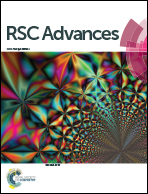Microwave-assisted surface-initiated redox polymerization of acrylamide with functionalized graphene oxide for aqueous lubricant additive†
Abstract
A fast and efficient approach for the synthesis of nanocomposites of polyacrylamide-grafted-functionalized graphene oxide (FGO-PAM) through microwave-assisted surface initiated-redox polymerization (SI-RP) of acrylamide using functionalized graphene oxide and Ce(IV) ions as a redox couple in aqueous medium is reported. The nanocomposites are characterized by FT-IR, UV-Vis, Raman, XRD, TGA, FE-SEM, and HRTEM. These characterizations indicate a facile synthesis of macromolecular brushes of polyacrylamide on the surface of the graphene oxide. The high dispersion ability and composition ratio of the components facilitate the exploration and evaluation of the lubrication characteristics of this nanocomposite as an additive in an aqueous medium. The results showed a substantial reduction of the friction coefficient (46–55%) and improvement in anti-wear properties (13–37%), due to the formation of lubricating nanolayers of the nanocomposite between the two frictional surfaces, thus qualifying this nanocomposite as an aqueous lubricating additive for tribological application.


 Please wait while we load your content...
Please wait while we load your content...